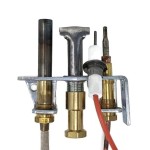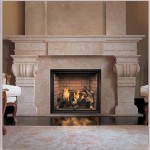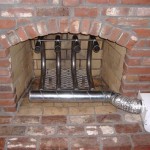Ventless Gas Logs for See-Through Fireplaces: A Comprehensive Guide
See-through fireplaces, also known as double-sided fireplaces, offer a unique aesthetic appeal, serving as a focal point connecting two separate living spaces. They provide visual warmth and ambiance, enhancing the overall design of a home. However, installing and operating a traditional wood-burning fireplace can be complex and present certain challenges, including the need for extensive venting and ongoing maintenance. Ventless gas logs offer a viable alternative, providing the look and feel of a real fire without the complexities associated with traditional fireplaces.
This article delves into the intricacies of ventless gas logs specifically designed for see-through fireplaces, exploring their operational principles, benefits, installation considerations, safety features, and maintenance requirements. The goal is to provide prospective buyers and homeowners with a thorough understanding of this technology to make informed decisions regarding their home heating and design.
Understanding Ventless Gas Log Technology
Ventless gas logs, unlike their vented counterparts, do not require a chimney or flue for operation. They achieve this by burning propane or natural gas with a high degree of efficiency, ensuring nearly complete combustion. This near-complete combustion process significantly reduces the production of harmful byproducts such as carbon monoxide. The small amount of water vapor and carbon dioxide generated is considered safe enough to be released directly into the living space, provided adequate ventilation is available.
The key to the functionality of ventless gas logs lies in the oxygen depletion sensor (ODS). This critical safety device continuously monitors the oxygen levels in the room. If the oxygen level drops below a predetermined threshold, indicating a potential buildup of carbon monoxide, the ODS automatically shuts off the gas supply to the logs, preventing a hazardous situation. This safety mechanism is a standard feature on all ventless gas log sets and is essential for their safe operation.
Ventless gas logs operate on either natural gas (NG) or liquid propane (LP). The choice between the two depends on the availability of gas lines and personal preference. Natural gas is generally considered more economical in areas where it is readily available through municipal pipelines. Propane, on the other hand, is stored in tanks, making it a suitable option for homes located in areas without natural gas infrastructure.
The aesthetic realism of ventless gas logs has improved significantly over the years. Manufacturers now employ advanced molding techniques and materials to create log sets that closely mimic the appearance of real wood, including intricate bark textures, varying sizes, and realistic coloration. Some models even incorporate glowing embers and flickering flames to enhance the illusion of a genuine wood-burning fire.
Heat output is measured in British Thermal Units (BTUs). Ventless gas logs are available in a range of BTU ratings to accommodate different room sizes and heating needs. A higher BTU rating indicates a greater heat output, suitable for larger spaces. Selecting the appropriate BTU rating is crucial for achieving optimal comfort and avoiding overheating the room.
Advantages of Ventless Gas Logs in See-Through Fireplaces
Choosing ventless gas logs for a see-through fireplace presents several advantages over traditional wood-burning options and even vented gas log systems. These advantages contribute to cost savings, convenience, and enhanced energy efficiency.
One of the most significant benefits is the elimination of the need for a chimney or flue. This significantly reduces installation costs, as there is no need to construct or modify existing venting systems. This is particularly advantageous for see-through fireplaces, where venting can be complex and expensive due to their location and configuration. A ventless setup offers greater flexibility in fireplace placement and design.
Ventless gas logs boast a high energy efficiency rating, typically ranging from 99% to 100%. This means that nearly all the heat generated by the burning gas is transferred directly into the room, minimizing energy waste. This high efficiency translates to lower heating bills compared to traditional wood-burning fireplaces or vented gas log systems, which lose a significant amount of heat through the chimney.
Convenience is another key advantage. Ventless gas logs are easy to operate, often requiring only the push of a button on a remote control or a switch on the unit itself. This eliminates the need to gather, stack, and light wood, as well as the chore of cleaning up ashes. The consistent and controllable heat output provided by ventless gas logs ensures a comfortable and predictable indoor environment.
The visual appeal of a fire is undeniable, and ventless gas logs provide this aesthetic without the mess and hassle associated with wood. The realistic flames and glowing embers create a cozy and inviting atmosphere, enhancing the ambiance of both rooms connected by the see-through fireplace. Modern ventless gas logs are designed to be visually indistinguishable from a real wood fire, blurring the lines between authenticity and convenience.
Safety is paramount with ventless gas logs. As previously mentioned, the Oxygen Depletion Sensor (ODS) is a standard safety feature that automatically shuts off the gas supply if oxygen levels drop too low. This crucial safety mechanism helps prevent carbon monoxide poisoning, ensuring the well-being of occupants.
Installation and Safety Considerations for See-Through Fireplaces
While ventless gas logs offer ease of installation, it is crucial to adhere to specific guidelines and safety precautions to ensure proper and safe operation, especially in the context of a see-through fireplace. These fireplaces, connecting two rooms, require careful consideration of ventilation and placement.
Installation should always be performed by a qualified professional, such as a licensed plumber or gas technician. This ensures compliance with local building codes and safety regulations. The professional will inspect the existing fireplace structure, verify the gas line connection, and properly install the gas log set according to the manufacturer's instructions.
Adequate ventilation is essential for the safe operation of ventless gas logs. While they are designed for nearly complete combustion, some byproducts are still released into the room. It is important to ensure that the rooms connected by the see-through fireplace have sufficient natural ventilation, such as operable windows and doors. Following the manufacturer's recommendations regarding room size and ventilation requirements is crucial.
Carbon monoxide detectors should be installed in both rooms connected by the see-through fireplace. These detectors provide an early warning system in the event of a carbon monoxide leak, regardless of the source. Regular testing of the detectors is crucial to ensure they are functioning properly.
Regular maintenance is essential for maintaining the efficiency and safety of ventless gas logs. This includes cleaning the logs and burner assembly periodically to remove dust and debris that can interfere with combustion. The ODS should be inspected regularly to ensure it is functioning correctly. Any signs of damage or malfunction should be addressed immediately by a qualified technician.
Proper sizing of the gas log set to the fireplace opening is crucial. An undersized log set will appear aesthetically unappealing, while an oversized set can create a fire hazard. Consult the manufacturer's specifications and measure the fireplace opening accurately to select the appropriate size.
The type of gas (natural gas or propane) must be compatible with the ventless gas log set. Using the wrong type of gas can damage the unit and create a safety hazard. Verify the gas type before installation and ensure the gas line is properly connected.
Keep combustible materials away from the fireplace opening. This includes furniture, curtains, and other flammable items. Maintain a safe distance to prevent accidental fires.
Educate all household members on the safe operation of the ventless gas logs, including how to turn them on and off, the location of the carbon monoxide detectors, and the importance of ventilation. Clear instructions should be readily available near the fireplace.
By adhering to these installation and safety considerations, homeowners can enjoy the warmth and ambiance of ventless gas logs in their see-through fireplace with peace of mind.

Double Sided Gas Logs Vented And Ventless Sets

18 Evening Embers See Thru Ventless Gas Fireplace Logs

Monessen Designer Ventfree See Thru Fireplace With Multi Side Log Set Fine S Gas

Breckenridge See Through Vent Free Firebox Fine S Gas

Monessen Nbst27 Natural Blaze See Through 27 Inch Vent Free Gas Log Set

Designer Lo Rider See Thru Vent Free Firebox Stacked Liner Monessen

Real Fyre Ecv 2 Evening Charred Ventless Gas Log Set See Thru Ansi Certified

Double Sided Gas Logs Vented And Ventless Sets

Napoleon Gvfl24 Ventless Gas Log Set 24 Inch

Vantage Hearth Vent Free Gas See Thru Firebox
Related Posts








